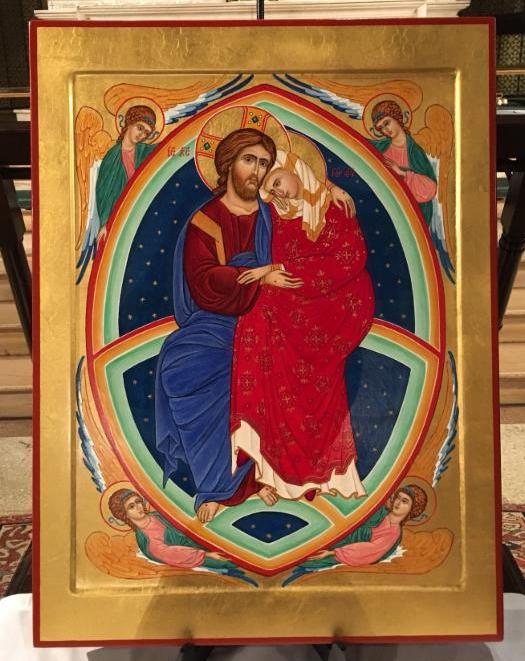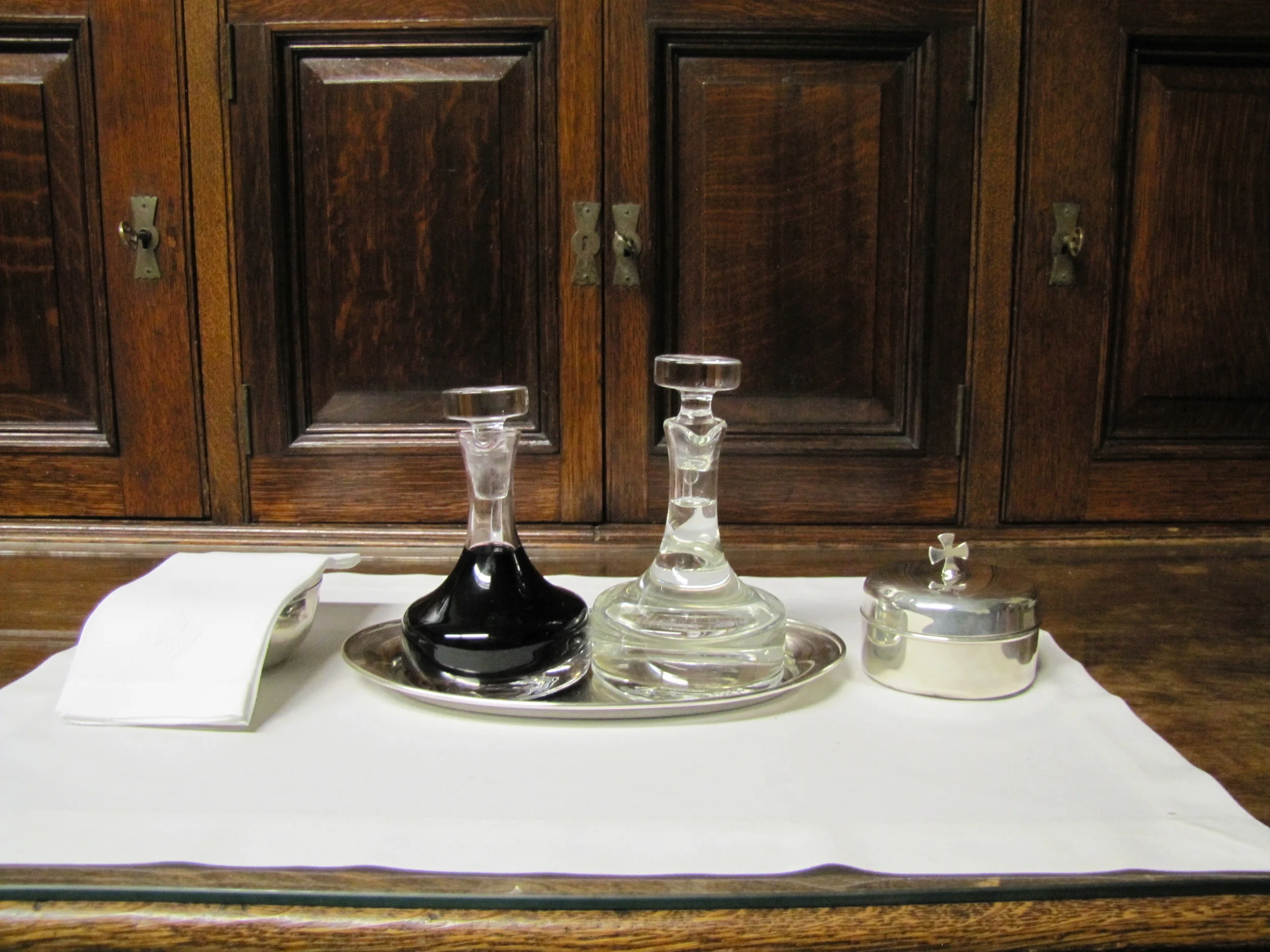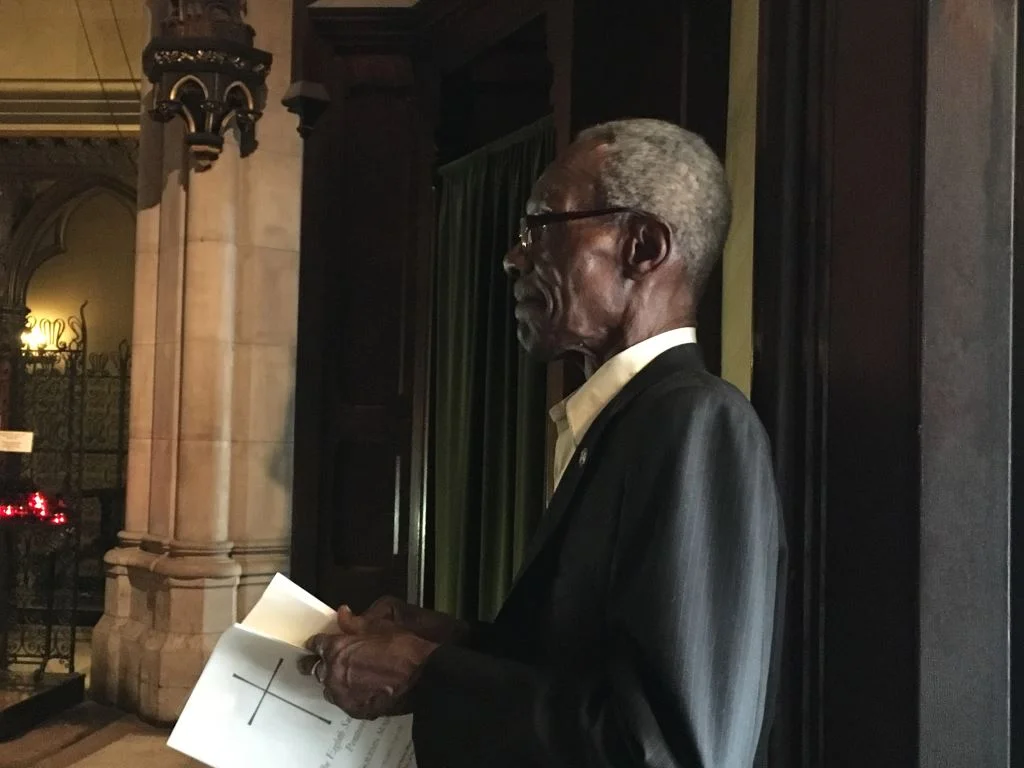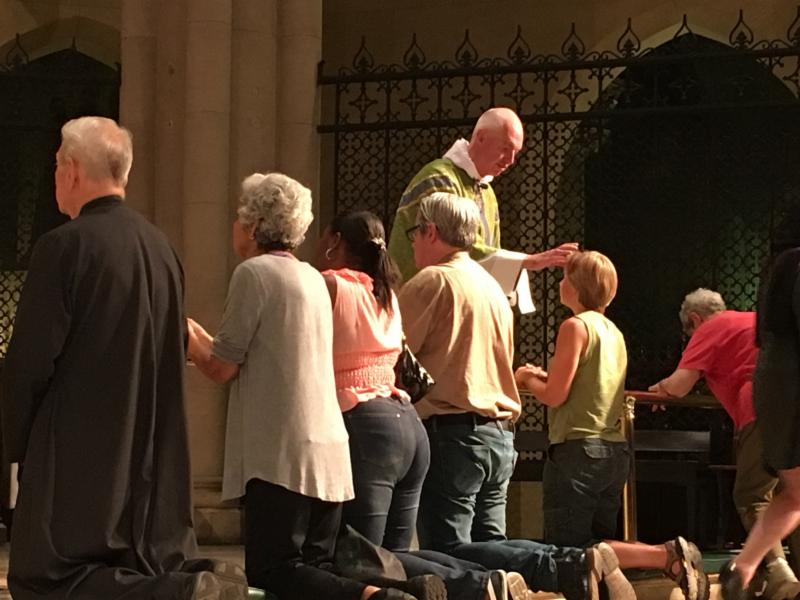The Angelus: Our Newsletter
VOLUME 18, NUMBER 51

FROM THE RECTOR: A NEW PRAYER
Very gradually over the past month or so, I've realized that my experience of daily common prayer has changed. While praying the canticles, the creed, and the regular prayers, and sometimes even when officiating, I am going to a place where the words just seem to be coming out of my mouth without me reading or thinking them. It doesn't seem like memory to me. I don't have to think about it. It's almost involuntary. I sense I just need to be there in church at the right time for my spirit to be in a new place, aware in the now in a new way.
Read MoreVOLUME 18, NUMBER 50

FROM THE RECTOR: GUTTERS AND ROOFS
Most weeks Office Manager Chris Howatt and I meet with the job leaders for our renovations from the architectural firm Jan Hird Pokorny Associates, Inc. (JHP), and the construction firm West New York Restoration of CT, Inc. (WNY). The work began when scaffolding went up across the 47th Street façade on December 9, 2015. It went up then so that the terra cotta stones on the roof could be taken down and restored or replicated as required. The roof work is essentially complete save for the reinstallation of the terra cotta. I learned at this week's meeting that all of the new terra cotta units are on the truck. My hope is that most of the scaffolding will be down by Thanksgiving Day. The sidewalk bridge will remain in place because problems were discovered with the carved stones set around the 47th Street entrance and with the limestone ornamentation atop the Lady Chapel roof.
VOLUME 18, NUMBER 49

FROM THE RECTOR: CELEBRATING THE SAINTS
Most of the great festivals of the church year are associated in my mind with hymns. It really does feel like the morning of the resurrection when, at the end of the Great Vigil of Easter, we sing "Jesus Christ is risen today, Alleluia!" For me, it really is Christmas when the organ begins to introduce our final hymn at the Christmas Eve Masses, "Hark! the herald angels sing." At Epiphany it's "Brightest and best of the sons of the morning"-to the tune Star in the East. For Trinity Sunday it's "I bind unto myself today the strong Name of the Trinity." And of course for All Saints' Day, it's "For all the saints." This hymn will be sung at the 12:10 PM Sung Mass and at the 6:00 PM Solemn Mass on Tuesday, November 1, All Saints' Day
Volume 18, Number 48

FROM MICHAEL DEVONSHIRE: REVEALING THE FAÇADE
"There is no sculptural art in America . . . You'll starve!" In this way, John Massey Rhind (1860-1936) was warned away from venturing to America in his ambition to follow his training as a sculptor and make his way in the United States. He ignored his father's admonition, and the Church of Saint Mary the Virgin is so much the better for it. In the creation of the church complex, John Massey is responsible for no fewer than six important sculptural images. The sculptures are presently in good condition, showing very little erosion of the surfaces, something that is generally expected in the New York City's atmosphere. Close inspection of the pieces is not possible, however, due to the protective netting and the sidewalk bridge.
Volume 18, Number 47

FROM THE RECTOR: SHOWING UP
Last week I was a guest at the annual conference of the North American province of the Society of Catholic Priests (SCP), which took place this year in Atlanta, Georgia. SCP describes its "twin aims [as] the cultivation of priestly spirituality and the encouragement of catholic evangelism." The members of the North American province (SCP also has a European province) are bishops, priests, and deacons-both women and men-of the Episcopal Church and the Anglican Church of Canada.
Read MoreVolume 18, Number 46

FROM STEVEN HEFFNER: GIFTS OF TIME, TREASURE & TALENT
For more than ten years, I've had the honor of serving on the stewardship committee at Saint Mary's. I'm not sure that most people would consider service on the stewardship committee "an honor"--probably more like the unenviable task you try to duck! However, for me it's been a blessing. Even through a number of challenging financial times, I've had a front-row seat for an even greater number of miraculous responses from the Saint Mary's community and experienced a host of unexpected delights in the work of stewardship.
Volume 18, Number 45

FROM THE RECTOR: FALL IS HERE
The first Sunday in October is the beginning of the regular schedule of services. The service times don’t change for us, but the parish choir is back to sing at Solemn Masses on Sundays and principal feasts. On summer Sundays, Morning and Evening Prayer are read. Beginning this Sunday and through Morning Prayer on Corpus Christi 2017, Sunday Morning Prayer is chanted and Solemn Evening & Benediction is offered on Sunday evenings. The Wednesday night Bible study is already underway; adult education returns this Sunday as well. Of course, our doors are open and the regular services of the church are offered daily. Fall is here.
Volume 18, Number 44

FROM THE RECTOR: OUR PRAISE AND THANKSGIVING
In my seminary years we learned that the sharp division between the Christian and Jewish communities, as reflected in most of the New Testament, arose after the Great Jewish Revolt (AD 66–70). It seems that for some time scholars have placed the hardening of this division toward the end of the period called “Late Antiquity,” AD 200–700 (C. E. Fonrobert, “Judaizers, Jewish Christians, and Others,” The Jewish Annotated New Testament [2011], 555). So I wasn’t surprised to find, at the beginning of Through the Eye of a Needle: Wealth, the Fall of Rome, and the Making of Christianity in the West, 350–550 AD (2012) by Peter Brown, that Professor Brown writes about commonalities in the earlier part of this period.
Volume 18, Number 43

FROM THE RECTOR: TOSSING CORPORALS
The first Book of Common Prayer (1549) didn’t mention what was to become a familiar phrase for Anglicans everywhere, “fair white linen.” It was introduced to the second English Prayer Book in 1552. This is the sentence from the 1552 book: The Table hauyng at the Communion tyme a fayre white lynnen clothe upon it, shall stand in the body of the Churche, or in the chauncell, where Morning prayer and Evening prayer be appointed to bee said” (The First and Second Prayer Books of King Edward VI, Everyman’s Library [1964], 377). The present American Book of Common Prayer Book simply says, “The Holy Table is spread with a clean white cloth during the celebration” (page 406)—at Saint Mary’s the cloths used at the altar, small and large, are still linen.
Volume 18, Number 42

FROM FATHER SMITH: IN MEMORIAM
Like many New Yorkers, I remember that September 11, 2001, was a startlingly clear, cool, sunny early-autumn day here in the city. It is incongruous that one of the things that we remember about that terrible day is the weather. We do so, I suppose, because for many of us the memories of the day are so vivid and so visual, and because the smoke and the ash that blanketed lower Manhattan on that Tuesday morning were such a shocking and cruel violation. As all who read this know, on the morning of September 11, 2001, Al Qaeda terrorists boarded and then hijacked three commercial airliners and carried out coordinated attacks against the World Trade Center and the Pentagon in Washington, D.C., killing everyone on board the planes and nearly 3,000 people in the buildings and on the ground. A fourth plane crashed into a Pennsylvania field, killing all on board, after passengers and members of the crew attempted to take control from the hijackers. Many others survived the attacks but were injured. (See http://www.history.com/topics/9-11-timeline.)
Volume 18, Number 41

FROM FATHER SMITH: EVERYDAY EATING
A couple of months ago, one late Saturday afternoon, I preached a homily to a small congregation here at Saint Mary’s. It was warm in the church. We’ve had some pretty hot days here in New York this summer, and the church doors were open. But it was mercifully quiet out there in our neighborhood. They’re building a hotel on the corner of Forty-seventh Street and Seventh Avenue, and that has slowed traffic down to a trickle. The sound of outraged drivers honking their horns is an everyday occurrence. You learn to speak up, or, when it gets really bad, you close the doors. But it was Saturday afternoon getting on toward evening. The construction workers had gone home, and the late-night weekend revelers, who only emerge after the sun goes down, were still taking their naps. It was quiet in the church as we welcomed the Lord’s Day, and that was nice.
Read MoreVolume 18, Number 40

FROM THE RECTOR: DIMINUTION
While away from the parish earlier this year, I ended up attending the main service of a significant urban Episcopal parish in a significant town. As I entered I was handed a bulletin that identified the service as “Holy Eucharist, Community & Song.” Before the service the celebrant spoke to us about the special service we would be having that day. We learned there had been a workshop the day before and that the content of the workshop would be shaping our morning worship. This announcement seemed to assume that everybody present knew and understood the parish’s liturgical traditions and customs. There was no acknowledgment that visitors might be present; it was very much what I call “club religion.”
Volume 18, Number 39

FROM THE RECTOR: AUGUST NEWS
During my first year at Saint Mary’s, a parishioner observed that if one didn’t work hard in the summer, the fall would be overwhelming. That doesn’t mean people don’t get vacations; what it means is that there’s usually a lot going on. I want to tell you about some of the things that are happening here at the parish.
Volume 18, Number 38

FROM THE RECTOR: BIBILICAL INCLUSION
The Prayer Book gives permission to lengthen any lesson at the Daily Office. Reading the Bible and being honest about all of what it says and doesn’t say, I believe, is the greatest defense our minds and hearts can have against fundamentalism in all its forms. So, at Saint Mary’s we omit nothing from the New Testament at the Office. The Old Testament, however, presents different challenges.
Volume 18, Number 37

FROM THE RECTOR: FOOD AND DRINK
On Easter Day, April 18, 1965, the bulletin for the “High Mass,” as it was then called at Saint Mary’s, records the occasion when, for the first time, the Lord’s Prayer was sung by the congregation at the main service. Until that time, only the celebrant chanted it. Father Donald Garfield was the new rector. He had begun his ministry here on February 1, 1965. But an even more important change would come on Sunday, May 2, 1965: the congregation would be invited to receive communion at the 11:00 AM service. From the foundation of the parish until then, the main Sunday service was what was called a “noncommunicating High Mass”—at which only the celebrant received communion. Some will not know that the altar rail is removable and was removed for these Masses at which no one but the celebrant received communion.
Read MoreVolume 18, Number 36

FROM THE RECTOR: LORD’S PRAYER AND MORE
Last Sunday’s gospel included Luke’s version of the Lord’s Prayer—as it does every three years in the lectionary cycle. This year I had one additional resource in preparing my sermon: The Didache: A Commentary (1998) by Kurt Niederwimmer. “Didache” is a Greek word; it means “teaching.” The Didache is a text I learned about in seminary, “approximately the length of Paul’s Letter to the Galatians” (Niederwimmer, 1). It’s not a gospel, but a manual about the common life of the unnamed author’s community. Scholars now generally date this text to the 90s—contemporary with the Gospel According to John. (Matthew and Luke were probably written a decade earlier.) The Didache was known in the first centuries of the Christian era but last referenced in a text dated 829. Its rediscovery in 1883 was a major scholarly find.
Read MoreVolume 18, Number 35

FROM THE RECTOR: REAL CHANGE
When I began attending the Leadership in Ministry workshops, one of the rites of passage, as it were, was to watch the 1995 movie Cold Comfort Farm. It’s hilarious, but it’s also very much a “family systems” story. I watched the 2015 movie Spotlight this week. It is not a comedy, but it is very much a family systems theory movie. I had forgotten it won the Academy Award for best picture in January. It is based on a familiar and all-too-real, tragic story.
Volume 18, Number 34

FROM THE RECTOR: GROUNDED UPON SCRIPTURE
The Bible means more to me at this point in my life than I ever imagined it would, and a very great part of this has come from the many years now I have prayed Daily Morning and Evening Prayer. It took years for me to fall in love with the Acts of the Apostles, but fall I have—and I’m pretty close to a new and better relationship with the Book of Job. The journey with the Daily Office began, at the direction of my rector, when Bishop James Montgomery, IX Bishop of Chicago, accepted me as a postulant.
Read MoreVolume 18, Number 33

FROM THE RECTOR: OPPORTUNITIES
As I write on Friday morning, July 8, the news from Dallas, Texas, continues to come in. Sometime today—after this newsletter gets out—I expect to post on the parish webpage two very fine sermons preached by Father Peter Powell. I invite you to read both of them. In his sermon preached on June 19 he said, “The tragedy in Orlando points out for the umpteenth time that we compromise with evil to our peril.” Last Sunday he said, “We frequently act as if the only rational response to evil is to meet it head on and in kind. Is there another way?” I invite everyone to read these sermons.
Volume 18, Number 32

FROM THE RECTOR: SUMMER READING
A few weeks ago I picked up my copy of The Oxford Movement: Twelve Years: 1833–1845 by Richard William Church (1815–1890). The edition I have was published in paperback by the University of Chicago Press in 1970, and it was still selling when I got to graduate school there in the fall if 1976. I had been attending the Episcopal Church in college. I would soon become an Episcopalian at the local Episcopal parish in Kenwood and was active with the group at Brent House, the campus Episcopal chaplaincy.